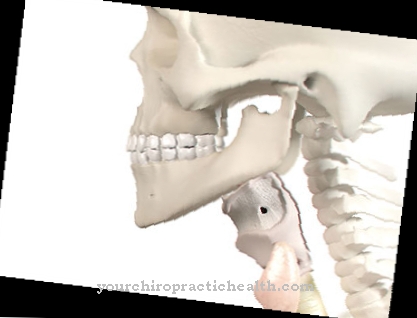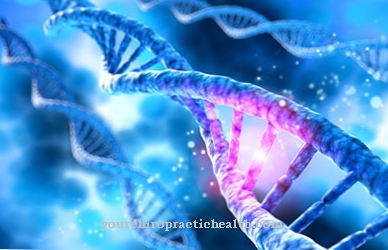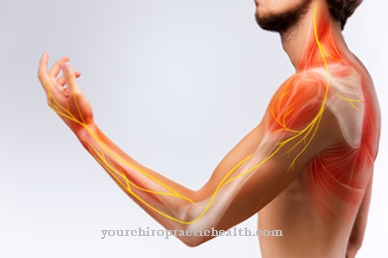At the EEC syndrome it is a rare disease that is present at birth. The abbreviation stands for the terms E.ctrodactyly, E.ctodermal dysplasia and C.left (English name for cleft lip and palate). The term disease thus summarizes the three most important symptoms of the EEC syndrome. Patients suffer from a split hand or split foot and defects in ectodermal dysplasia.
What is EEC Syndrome?

© Maos - stock.adobe.com
The EEC syndrome is a disorder in the development of the affected person that is already fixed at birth. The EEC syndrome develops as a result of genetic mutations in the patient. The three typical complaints of the EEC syndrome are ectodermal dysplasia, ectrodactyly and an orofacial cleft.
Basically, the EEC syndrome occurs extremely rarely. Although the exact frequency of the disease is not known, there are currently only a little more than 300 cases in the medical literature. In 1970, several doctors distinguished the EEC syndrome as an independent disease from other diseases with similar symptoms.
These are the physicians Passarge, Rüdiger and Haase. The EEC syndrome is characterized by an autosomal dominant mode of inheritance. According to presumptions, the first description of the disease was made in 1804 by the doctors Martens and Eckoldt.
causes
In principle, the EEC syndrome arises from gene mutations on certain gene sequences. In the majority of cases, the EEC syndrome develops through so-called missense mutations. These take place on a gene called TP63 at the gene locus 3q27. This gene is responsible for coding a transcription factor that plays an important role in the formation of extremities and the ectoderm.
Mutations on this gene are associated with the typical EEC syndrome. The phenotype and the genotype usually correlate. With other mutations, patients suffer from deformities of the inner ear and the auricle. The EEC syndrome is inherited in an autosomal dominant manner. The penetrance of the EEC syndrome is between 93 and 98 percent and is therefore not complete. The expressivity of the disease is also variable.
Symptoms, ailments & signs
The symptoms of the EEC syndrome differ greatly in individual cases. The various genetic mutations are primarily responsible for these variations. Typical signs of the EEC syndrome consist of syndactylies, a split foot or a split hand and a cleft lip and palate on both sides. In some cases, however, there is only a cleft lip.
The tear ducts of patients with EEC syndrome are mostly affected by atresia, and the people are photophobic and suffer from conjunctivitis, chronic blepharitis and dacryocystitis. The patient's iris is usually blue in color. The attachments for the teeth are often not available or too small.
The incisors are less than average in appearance and resemble pencils in their shape. The hair on the head grows only sparingly, and the growth of eyelashes and eyebrows is also weak. Patients often have light, blonde hair that curls easily. Most of the time, the auricles are deformed, and people also suffer from impaired hearing.
There is also choanal atresia, hypohidrosis and hyperkeratosis. The nails on the fingers and toes are often deformed in EEC syndrome. The kidneys and urinary tract can also be affected by malformations. The patients mostly have dry skin that produces only a few pigments and is therefore very light.
In principle, the typical signs of the EEC syndrome vary in individual cases with regard to their severity. The main symptoms also do not occur in common in all sufferers. However, most people affected by EEC syndrome have an average intelligence, while physical development is often delayed.
diagnosis
Various medical specialists are involved in diagnosing EEC syndrome. In the consultation with the patient, the doctor tries to find out the symptoms and the medical history as precisely as possible. Visual and X-ray examinations play an important role in the clinical examination.
Depending on the localization of the symptoms, the doctor depicts, for example, the jaw or the extremities. He also examines the kidneys using ultrasound technology. The doctor takes swabs from the skin and arranges a laboratory histological analysis of the samples.
A reliable diagnosis of the EEC syndrome is usually only possible with the help of a genetic test. The doctor identifies the typical genetic mutations that trigger the EEC syndrome. In some embryos, the EEC syndrome can already be detected during pregnancy.
Appropriate prenatal examinations are particularly useful in families in which such mutations have already occurred. In the differential diagnosis, the attending physician differentiates EEC syndrome from Hay-Wells syndrome and ectodermal dysplasia.
Complications
The complications of EEC syndrome and its severity are very different for most people. Most patients, however, have a split foot and split hand. The lip can also be affected by a crevice. The EEC syndrome leads to inferiority complexes and a reduced self-esteem in many patients due to the changed appearance.
The quality of life is significantly reduced by the syndrome. In many cases the teeth are also affected by malformations. Hair growth is also limited, so that there is almost no formation of hair on the head or on the eyebrows. Often children suffer from EEC syndrome because they are teased because of their changed appearance.
Most often, patients experience hearing loss and dry skin. The intelligence is usually not affected by the EEC syndrome and can develop in the usual way. Unfortunately, there is no treatment for EEC syndrome. However, surgical interventions can be carried out to correct the malformations cosmetically.
Physiotherapy is also often carried out to strengthen the patient's movements. There are no further complications with the treatment methods. However, the patient has to live with the symptoms of EEC syndrome his entire life.
When should you go to the doctor?
Since the EEC syndrome has usually been present since birth, there is no need to visit a doctor for diagnosis. However, since those affected suffer from various malformations and deformities, a doctor should always be consulted if this leads to restrictions and complaints in everyday life. The teeth and ears can also be affected by this syndrome and should be corrected if necessary. An ENT specialist should be consulted if the patient suddenly suffers from hearing loss.
Since the mental and physical development of the child is also significantly slowed down by the EEC syndrome, a medical examination and further support are necessary. This can avoid discomfort in adulthood. A psychologist must also be consulted if the child or the parents have psychological problems. Furthermore, the EEC syndrome can also lead to malformations of the kidneys or the urinary tract, so that these areas of the body should also be examined regularly. If the treatment is successful, the patient's life expectancy does not usually decrease.
Doctors & therapists in your area
Treatment & Therapy
A causal therapy of the EEC syndrome is not possible. However, the patients usually receive symptomatic treatment that is tailored to their symptoms by means of surgical cosmetic corrections and orthodontic therapy. Physiotherapy is also helpful for most patients. The prognosis of the EEC syndrome is in principle favorable, so that the sick mostly reach a normal age.
Outlook & forecast
The prognosis for an EEC syndrome is usually very favorable. Usually life expectancy is not reduced. In rare cases, however, complications can occur that can be fatal. Very few cases of this autosomal dominant mutation have been described to date. But since the clinical picture is very variable, a larger number of unreported cases is assumed.
The disease is characterized by the three cardinal signs cleft hands and split feet, cleft lip and anomalies of various ectodermal structures, but all symptoms are different in individual people and do not have to occur at the same time. This variability also determines the individual prognosis for the disease.
If hypohidrosis, i.e. the reduced ability to sweat, is one of the dominant symptoms, there is always the risk of life-threatening complications. Due to the reduced perspiration, the body heat cannot be effectively dissipated if the clothes are too thick, the outside temperature or physical exertion are too high, which can lead to deaths due to heat build-up. Therefore, the correct treatment of hypohidrosis is one of the most important elements of therapy for EEC syndrome.
Some people also suffer from hearing loss. In addition, constant ophthalmological treatment is required to prevent cataracts or corneal scars. Although life expectancy is almost normal, the quality of life is often limited by the many visible anomalies. In individual cases this can lead to psychological problems and social exclusion.
prevention
The EEC syndrome is of a genetic nature and thus eludes preventive measures. Only prenatal diagnosis can be carried out. However, the disease hardly limits the patients in their life expectancy.
Aftercare
In the case of the EEC syndrome, the measures or options for follow-up care are usually very limited. Since this is also a congenital disease, it cannot be treated completely and therefore only symptomatically. Complete healing cannot be achieved.
The earlier the EEC syndrome is recognized, the better the further course of the disease will usually be. Should the patient wish to have children in the course of their life, genetic counseling can also be carried out. This may prevent the syndrome from being passed on. The treatment of the EEC syndrome is usually carried out with the help of physiotherapy, so that the person's mobility is increased.
Some of the malformations can also be corrected in the process. In many cases, the person affected can do the exercises on their own at home and thus promote recovery. After an operation, it is important to ensure bed rest so that the body can recover. Psychological support is also very useful in the EEC syndrome so that depression and other psychological upsets do not occur. In most cases, the life expectancy of the person affected is not reduced by the EEC syndrome.
You can do that yourself
With the EEC syndrome, the patients have no way of achieving a change or healing of the physical abnormalities with their own capacities. The hereditary disease has so far been considered incurable. Medical cooperation must take place to correct certain impairments.
In everyday life, those affected can take various measures to strengthen their emotional state. Participation in self-help groups or the digital exchange with other sick people can be perceived as very helpful. In contact, mutual assistance can be given and the challenges in daily dealing with the disease can be discussed. Relatives should inform the sick child as early as possible about the EEC syndrome, its symptoms and the course of the disease.
Boosting self-confidence and answering all questions are important to clear up ambiguity and avoid surprises. Family members who are also suffering from the EEC syndrome can report on their experiences and offer support for the child. Everyday obstacles can be overcome together. The awareness should also focus on the strengths of the child. Joint activities, in which a sense of achievement can be built, offer themselves to promote self-confidence and improve the quality of life.




.jpg)

.jpg)




















